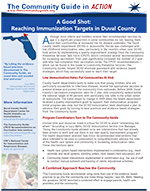A Good Shot: Reaching Immunization Targets in Duval County
Summary
 The Duval County Health Department in Jacksonville, Florida was challenged with low childhood immunization rates, particularly in its urban core. By implementing a quality improvement strategy that combined multiple Community Guide recommendations, they reached the national target within one year. (Released 2012)
The Duval County Health Department in Jacksonville, Florida was challenged with low childhood immunization rates, particularly in its urban core. By implementing a quality improvement strategy that combined multiple Community Guide recommendations, they reached the national target within one year. (Released 2012)Lessons Learned
- Take advantage of work already done. All of the interventions included in the Community Guide have been scientifically reviewed and classified. Save valuable time and resources by using interventions proven to work.
- Combine interventions for greater impact. The Community Guide often identifies multiple interventions that address a public health problem from different angles. DCHD found that following the recommendation to implement interventions in combination worked to increase awareness, access, and demand for vaccinations in their community.
- Use the Community Guide as a multi-purpose tool. DCHD also used the Community Guide for validating budget reports to state legislators and grant writing for violence prevention activities. They have used the success of their immunization program as a stepping stone to champion the Community Guide across other departments and with community partners.
Story
Low Immunization Rates Put Communities at Risk
County health departments work to make sure that young children, who are particularly susceptible to infectious diseases, receive the appropriate vaccines to prevent disease and protect the community from outbreaks. Before 2009, Duval County’s vaccination completion rates for 2-year-olds consistently ranked below the national target of 90 percent, with particularly low rates in the urban center of Jacksonville. The trend began to change in 2009 when the health department received a quality improvement grant to support their immunization program. Initial progress was slow, but the DCHD immunization team developed a plan to advance their goals by turning to best practices and evidence-based strategies from the Community Guide.
Program Coordinators Turn to the Community Guide
Limited time and resources made it critical for DCHD to avoid “reinventing the wheel.” According to Lucy Wells, DCHD Immunization Service Line Manager, “Using the Community Guide allowed us to see interventions that had already been proven to work and use them in our own quality improvement program.” The health department selected Task Force-recommended interventions that were intended to be used in combination to comprehensively address the roles of the health care system and community in increasing immunization rates. These interventions were:
- Health care system-based interventions implemented in combination (e.g., client reminder and recall systems; standing orders; clinic-based client education), and
- Community-based interventions implemented in combination (e.g., the use of staff to conduct manual outreach and tracking of clients; educational activities).
A Combined Approach Reaches the Community
“The Community Guide recommends using more than one of the evidence-based practices to go into the community and make things happen,” says Ms. Wells. Heeding this guidance, DCHD launched a combined effort to engage parents, health care providers, and the community.
- Using the Florida Shots Registry, which tracks each resident’s vaccinations, clinic staff identified infants and toddlers who were due for, or had missed, vaccinations. They sent monthly reminders to parents about upcoming vaccination due dates and urged them to make appointments. For children behind on their immunization series, clinic staff reached out to parents through phone calls, letters, and home visits encouraging them to schedule “catch-up” vaccinations. DCHD also produced educational materials with vaccination schedules and safety information to help parents keep up with their children’s immunizations.
- At local clinics, DCHD trained additional staff to administer vaccines and instituted a standing order authorizing them to do so without the need for a physician or other practitioner with prescription privileges to be present. The goal was to increase access to vaccinations and avoid missed opportunities.
- DCHD established an Immunization Task Force comprised of community partners from the private sector and other organizations. This group worked with local hospitals to send a team of two nurses and one physician into the community each week to immunize children in churches and other locations. DCHD provided vaccines and hospitals provided staff.
Duval County Reaches its Target
Within one year, the percentage of 2-year-olds with complete immunization records rose from 75 to 90 percent, hitting the national target. One clinic in particular, which had the worst immunization rates of all the Duval County clinics, made remarkable progress, increasing from 74 to 92 percent in 18 months. Now that the target has been reached, DCHD has set their sights on raising the immunization rate to 95 percent by increasing the number of client reminders to 2 to 3 per month and engaging more community partners.
“We are trying to reach out to as many community health partners as we can,” says Ms. Wells. “As the health department, we can provide the vaccines and training if our partners can provide outreach to the community. Now that we have a model that is working, we really want to focus on the outreach piece.”
Based on the success of the immunization program, DCHD is applying interventions from the Community Guide to other areas such as tobacco-use cessation and prevention of sexually transmitted infections. DCHD continues to share the Community Guide with community partners to broaden awareness of interventions that work.
More Information
CDC’s National Center for Immunization and Respiratory Diseases
Community Preventive Services Task Force findings referred to in this story:
The Community Guide: Task Force Findings on Increasing Appropriate Vaccinations